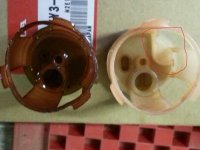I'm assuming you are trying to test for amperage per my last post??? Because, on most DVOMs, the u symbol (for micro) is only used in conjunction with measuring very small current flows. Milliamps refers to thousandths (.001 of an amp)
u or micro refers to millionths (.000001 of an amp)
Another way of saying it is:
1 amp is made up of 1,000 milliamps.
1 milliamp is made up of 1000 microamps.
In order to measure amps with a DVOM you need to move the negative lead from the "common" to the appropriate socket marked either A (for "whole" amps) or ma/ua for milli or micro amps.
If that is correct then what you are doing won't work for two reasons.
I believe that you are attempting to measure amperage by connecting your meter in PARALLEL with the circuit. DVOMs can only measure amperage in two ways; either through the use of a clamp type attachment that allows for induction measurement or by placing the meter in SERIES with the load. This requires that you physically disconnect a wire carrying power or providing ground to the pump and INSERTING the meter into the circuit so that it and it's leads carry the electrical load.
That pump may draw as much as 5 or 6 amps when working normally so using the u or micro amp "range" will yield no useful measurement even if the meter were properly attached and, possibly damage the meter. I don't know because I've never done it.
I DO NOT recommend hooking your meter in series with that circuit. Here's why:
Most DVOMs are designed and fused for measuring 10 amps MAXIMUM when measuring "whole" amps through the A socket and they are fused for 400 milliamps (less than 1/2 an amp) when using ma/ua socket.
I can honestly tell you that, on more than one occasion, I have seen guys hook their meter into a circuit carrying LESS than ten amps and the meter has smoked and died even while the 10 amp fuse did not blow! I did it myself one time with a Fluke brand DVOM. The fuse DID blow but the meter was damaged anyway. I was able to send it in and get it repaired under warranty but I have NEVER used a DVOM for measuring current in series since. It is just too easy to buy and use the clamp type meter or attachment if you are going to be doing this type of troubleshooting.
Also, the clamp or induction method of measuring amperage opens up a variety of testing scenarios for you like measuring how much load is really on that alternator when all the lights and the heater is running as well as how many HUNDREDS of amps your starter may be pulling off that cranking battery. VERY handy.
If you want to measure the current going through that pump, I STRONGLY recommend getting tooled up for induction type measuring.
If funds do not permit, then instead of measuring amps, measure output as outlined above by seeing what volume of fuel you can obtain from the pump in 15 seconds.
AND/OR...Voltage drop. Can't stress it enough. If you place your voltmeter leads PROPERLY in parallel with any part of the circuit that is not functioning as it should, you can read DIRECTLY from the meter how much voltage is being "stolen" from the pump. Please look/google it up and practice the technique. It serves guys like you, that aren't afraid of getting their hands dirty, a way to REALLY KNOW what the hays going on.
If you have only used a voltmeter hooked across + and -, the concept can be a little strange at first but, when you see how pretty much EACH AND EVERY connector, junction, clamp and component "robs" a small amount of voltage from the item you want to power, then you will AWAKEN to the importance of keeping all those connections CLEAN and TIGHT.


